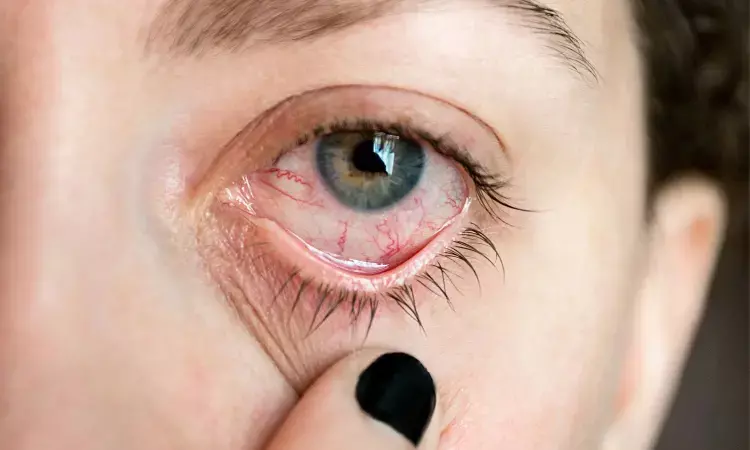- Home
- Medical news & Guidelines
- Anesthesiology
- Cardiology and CTVS
- Critical Care
- Dentistry
- Dermatology
- Diabetes and Endocrinology
- ENT
- Gastroenterology
- Medicine
- Nephrology
- Neurology
- Obstretics-Gynaecology
- Oncology
- Ophthalmology
- Orthopaedics
- Pediatrics-Neonatology
- Psychiatry
- Pulmonology
- Radiology
- Surgery
- Urology
- Laboratory Medicine
- Diet
- Nursing
- Paramedical
- Physiotherapy
- Health news
- Fact Check
- Bone Health Fact Check
- Brain Health Fact Check
- Cancer Related Fact Check
- Child Care Fact Check
- Dental and oral health fact check
- Diabetes and metabolic health fact check
- Diet and Nutrition Fact Check
- Eye and ENT Care Fact Check
- Fitness fact check
- Gut health fact check
- Heart health fact check
- Kidney health fact check
- Medical education fact check
- Men's health fact check
- Respiratory fact check
- Skin and hair care fact check
- Vaccine and Immunization fact check
- Women's health fact check
- AYUSH
- State News
- Andaman and Nicobar Islands
- Andhra Pradesh
- Arunachal Pradesh
- Assam
- Bihar
- Chandigarh
- Chattisgarh
- Dadra and Nagar Haveli
- Daman and Diu
- Delhi
- Goa
- Gujarat
- Haryana
- Himachal Pradesh
- Jammu & Kashmir
- Jharkhand
- Karnataka
- Kerala
- Ladakh
- Lakshadweep
- Madhya Pradesh
- Maharashtra
- Manipur
- Meghalaya
- Mizoram
- Nagaland
- Odisha
- Puducherry
- Punjab
- Rajasthan
- Sikkim
- Tamil Nadu
- Telangana
- Tripura
- Uttar Pradesh
- Uttrakhand
- West Bengal
- Medical Education
- Industry
Can hyaluronan cure dry eye disease?

As you read this are your eyes burning, itchy, tired, dry or red? If so, you may be one of 21 million people in the United States living with dry eye disease (DED). If you don't have it now, you may soon-the numbers are expected to rise as the population ages, and as anyone who suffers from it can tell you, it will decrease your productivity and reduce your quality of life.
Unfortunately, treatment options for DED are limited. What is known is that the Meibomian gland undergoes age-related changes that may account for the disease. Clinical studies suggest that 85% of all dry eye cases are caused by some form of Meibomian gland dysfunction (MGD). Meibomian glands are oil glands on the edge of the eyelids; the oil they produce is an important part of the eye's tears, keeping tears from quickly drying.
Enter a discovery in the lab of Vivien Coulson-Thomas, associate professor of optometry in the University of Houston College of Optometry: an extra cellular matrix or ECM (a network of proteins and other molecules) that surrounds and supports the Meibomian gland and is rich with hyaluronan (HA), a molecule known to protect and lubricate soft tissue.
Hyaluronan is widely used for treating numerous conditions, including application around the eyes and into the eyelids in order to reduce the appearance of wrinkles.
Coulson-Thomas has been awarded a $1.6 million grant by the National Eye Institute to put those puzzle pieces together and further examine Meibomian glands' extra cellular matrix, the role of hyaluronan and whether an increased amount or HA in the gland can prevent age-related Meibomian gland dysfunction.
She believes it can, with research findings indicating that an increase in HA expression in and around the MG can maintain viable progenitor cells which, in turn, prevents age-related MGD. Progenitor cells, like stem cells, can become other types of cells.
Coulson-Thomas also aims to discover whether hyaluronan administration into the eyelids can be used to prevent dry eye disease, and that would be bombshell.
"This type of treatment requires reoccurring HA administrations, similar to BOTOX® treatment. Therefore, repeated HA applications into the eyelid has already been clinically demonstrated to be very well tolerated with negligible side effects (which are mostly associated with the administration procedure and not with HA)," said Coulson-Thomas.
"Thus, there is immense value in investigating whether this type of treatment, which is already available in the clinic for esthetic purposes, could also be used to treat a clinically relevant condition for which currently only palliative care is available."
The research team, which will also investigate how hyaluronan prevents MG atrophy, is the first to investigate the role of the extra cellular matrix in the Meibomian gland.
Reference:
Kim Y, Moon CH, Kim B-Y, Jang SY. Oral Hyaluronic Acid Supplementation for the Treatment of Dry Eye Disease: A Pilot Study. Journal of ophthalmology.
Dr Kamal Kant Kohli-MBBS, DTCD- a chest specialist with more than 30 years of practice and a flair for writing clinical articles, Dr Kamal Kant Kohli joined Medical Dialogues as a Chief Editor of Medical News. Besides writing articles, as an editor, he proofreads and verifies all the medical content published on Medical Dialogues including those coming from journals, studies,medical conferences,guidelines etc. Email: drkohli@medicaldialogues.in. Contact no. 011-43720751


